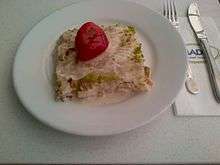Güllaç
 | |
| Course | Dessert |
|---|---|
| Place of origin |
|
| Main ingredients | corn starch, wheat flour, walnuts, milk, pomegranate |
|
| |
Güllaç (pronounced [ɟylˈlat͡ʃ]) is a Turkish dessert made with milk, pomegranate and a special kind of pastry. It is consumed especially during Ramadan.
Güllaç is considered as being the origin of baklava.[1] The similarities between the two desserts are many, such as the use of thin layers of dough and nuts in between. Güllaç dough is now prepared with corn starch and wheat flour, although originally it was made only with wheat starch. Güllaç contains walnuts between the layers that are put in milk.
Its first known mention is in a 14th-century book, Yinshan Zhenyao (飮膳正要), a food and health manual written by Hu Sihui (忽思慧), a physician to the Mongol court of the Yuan dynasty. The book documents primarily Mongol and Turkic dishes that exhibit a limited amount of Chinese influence.[1]
Güllaç was used for making Güllaç Lokması and Güllaç Baklavası, archaic Turkish desserts made during Ottoman period in Turkey. The etymology of Güllaç is combination of two words Güllü and aş, meaning "food with roses". Although the dessert itself may contain rose leaves and rose syrup, the name refers to the shape of layers which look similar to leaves of roses.
Elsewhere
A similar dessert called Umm Ali is made in Arabic cuisine. It differs primarily in that raisins are used instead of pomegranate seeds.